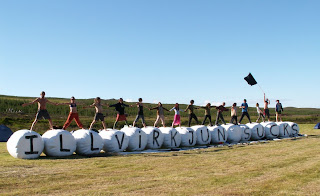National Geographic's March 2008 article titled "power struggle" looked at the on-going feud between the renewable sources of energy within Iceland and then the unspoiled landscape.
Iceland sits on a not only on a constructive plate boundary along the Mid-Atlantic ridge where the north American and Eurasian plates are diverging and pulling apart. As a result molten magma rises from the asthenosphere. This causes a build up of pillow lava, as the plates are continuously pulled apart lava cools and builds up until the submarine volcano protrudes out the water. Iceland also sits on a mantle plume called a hotspot. This 100-200km wide column of hot rock rises from deep within the earth, forcing magma through the lithosphere and out via volcanoes. This culmination of tectonic activity makes Iceland one of the most volcanic regions in the world.
 |
| Map of Iceland |
This unlimited source of geothermal and hydroelectric power has been long sought after whilst the Icelandic government has had to tempt companies to base in Iceland with the promise of cheap electricity to run their industry. One such company is Alcoa, the worlds third largest produced of aluminium. The Fjardaál smelter in eastern Iceland was completed in June 2007, The plant processes around 940 tons of aluminium a day, making it Alcoa's second largest smelter. However in order to harness the energy of Iceland's dramatic landscape a area covering 22 square miles had to be flooded. Not only will the flooding cause wide scale damage to the landscape, the rivers used in the project feed the islands main glacier called Vatnajökull. In total 3% of Iceland's land will be affected by the Dam itself.
 |
| Vatnajökull Glacier |
Kárahnjúkar is located in eastern Iceland, 700km away from the capital Reykjavik. The hydropower plant itself consists of nine dams, three reservoirs, seven channels and sixteen tunnels. The Jökulsá á brú and Jökulsá í Fljótsdal, and several smaller rivers are diverted to the north of the Vatnajökull glacier The main dam is over 190 meters tall making it the largest of its kind within Europe. The total cost of the project was 1.3 billion US Dollars and was funded by Landsvirkjun, the largest energy provider in Iceland. However it is likely the Icelandic tax payer will be contributing to the cost of the Dam despite not receiving any of the electricity produced. It's not just economic impacts that Iceland will face but it is likely that as the reservoir level raises and lowers the mud and silt left on the banks will dry and solidify and then the prevailing winds will carry dust, spoiling the pristine landscape. Many environmental activists initiated a protest camp at Kárahnjúkar. On the 19th July 2005, 25 activists shut down the site for 3 hours by locking themselves to a caterpillar construction vehicle and a pick up truck, blocking the main access roads. The pictures below come from the Kárahnjúkar protest camp on http://www.savingiceland.org. The last post from the camp was made in December 2011 reflecting on the long term impacts of the Dam. As expected the profits of the Dam were below the directors expectations, this is said to be due to the low price of energy sold to Alcoa's aluminium smelter.





